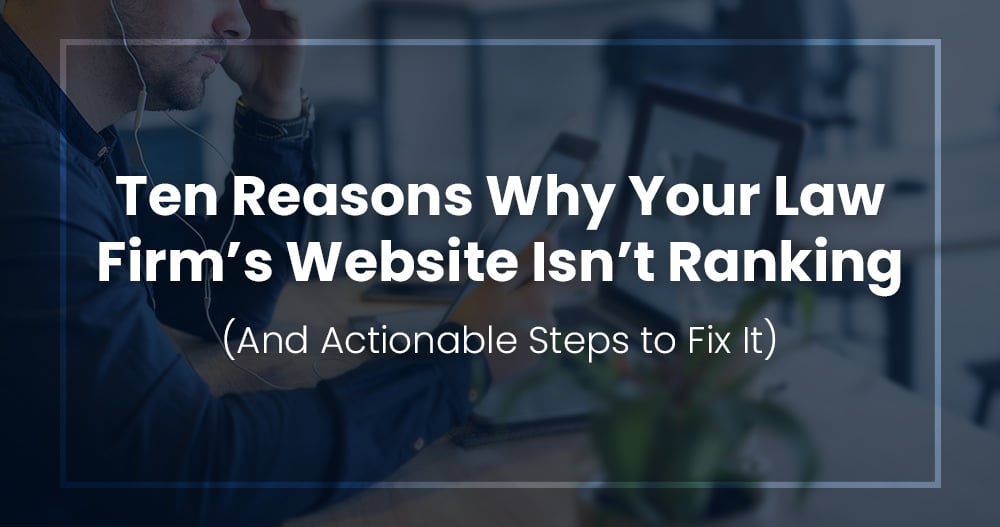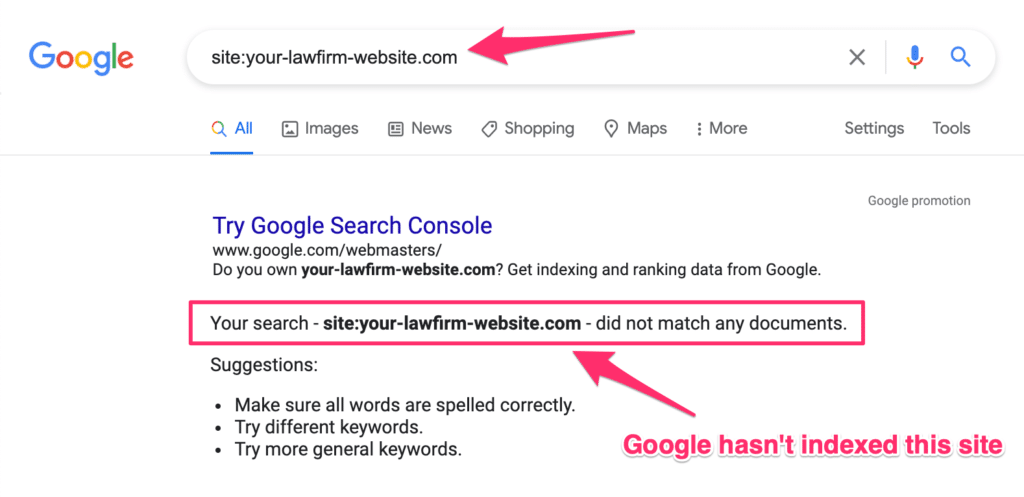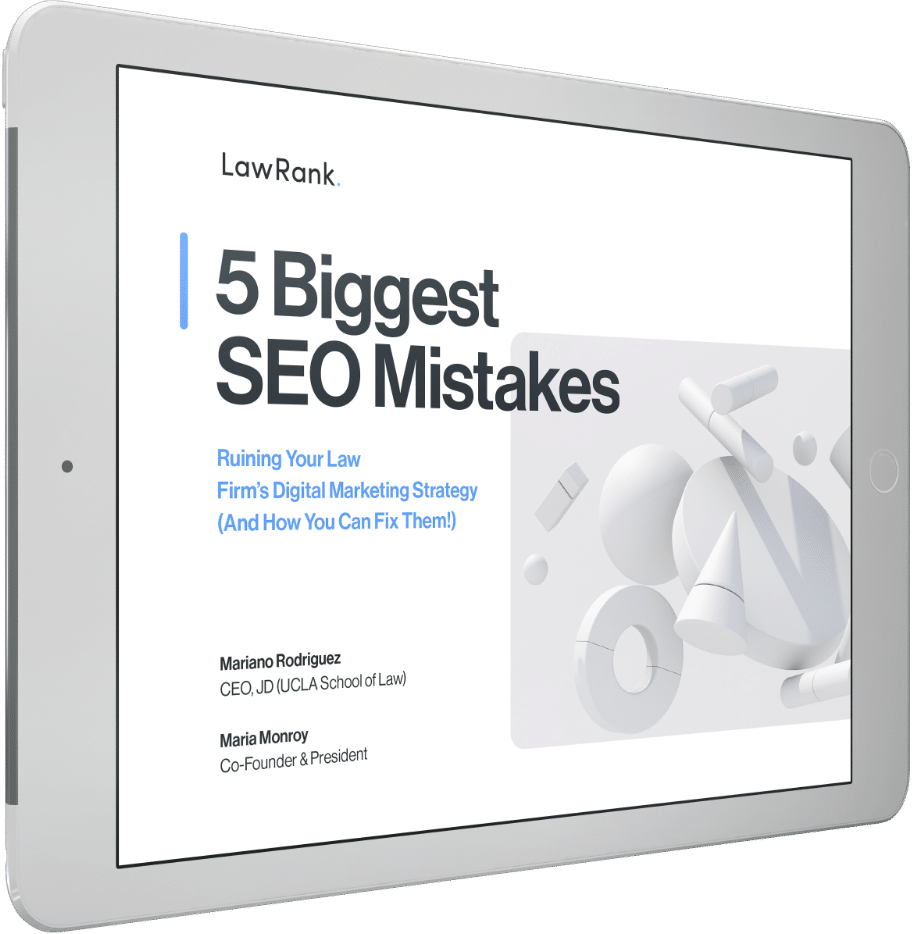
Search engine optimization (SEO) is a complex process. Sometimes, even when you follow all the right best practices – or have worked extensively with an external partner – your website still doesn’t seem to rank.
With significant time and resources expended on optimization, that result tends to be frustrating at best and demoralizing at worst.
This problem is all too common for attorneys. A search as seemingly localized and simple as “lawyer near me” can turn up more than 700 million results, depending on your location.
As legal SEO becomes more ubiquitous, getting a top result will only become more challenging.
Fortunately, getting your law firm website ranked where it can drive traffic and revenue is relatively straightforward – especially if some basic optimization is already in place. You just have to know what steps to take.
So, let’s dig into that. In this guide, we’ll examine ten common reasons why your legal website isn’t ranking as highly as it should on search results, and the steps you can take to fix the issue.
Reason 1: Your Website Isn’t Indexed
Let’s begin with a simple truth: you cannot rank if Google doesn’t even know your website exists. Google only ranks pages on its search results that it indexes on a regular basis.

Indexing might not apply to your website for a few reasons:
- Your website is too new. According to Google, it takes between four days and four weeks to index a new site. If you just launched, ranking might just be a matter of patience and checking back in a few weeks.
- You’re blocking Google from indexing your website. There are some compelling reasons to stop the indexing of specific pages (i.e., thank you pages, login pages, or intentional duplicate content). However, if you’re blocking the entire site, it won’t appear on Google.
- You’re blocking Google from crawling your website. Even though it might be indexed, Google will not rank your website highly if it receives crawl errors or specific instructions not to check your pages regularly.
These things mean that your website won’t appear on Google at all – much less rank highly.
So naturally, you’ll need to take some quick steps to ensure the problem is addressed.
How to Fix Google Indexing Issues:
1. Check to make sure your website appears on Google. Simply type site:your-website into the search console If no results appear and your website is relatively new – wait a week and check again.
If no results appear and your website isn’t new, move onto the following steps. You can use the same check for any specific page URL to ensure that it’s being indexed.

2. Check your robots.txt file. Robot.txt file tells Google and other search engines how to crawl your website. Enter your-website.com/robots.txt into your browser’s URL field. If you get a 404 error, create a robot.txt file.
Otherwise, check to make sure that the code tag Disallow: / doesn’t appear under User-agent: *, User-agent: Googlebot, or any of your important content sections. The command tells Google not to crawl these sections, which prevents them from ranking highly. Adjust your robots.txt file as necessary.
3. Remove the noindex meta tag from any pages you want to rank. This tag won’t appear by default but may have been added in the development process to ensure no unfinished pages show up before completion.
Reserve this tag only for special cases, and definitely don’t use it for entire sections or your website as a whole.
Reason 2: Site Speed is Hurting Your Website Ranking
Modern SEO is all about content, and we’ll get to some issues that bad content might cause. But, it’s important not to underestimate the technical issues that could plague your site. If the performance isn’t there, even the most compelling content won’t matter.

One of the most important pieces in this equation is site speed and page load time. Google actively prevents websites from ranking highly when they take too long to load.
Page speed has been a ranking factor for more than a decade, but it truly took center stage with a 2018 update that elevated its importance. Taking steps to ensure your website loads as fast as other legal websites vying for attention is crucial.
How to Fix Site Speed Problems:
1. Run a page speed test with a tool like Google PageSpeed Insights, Lighthouse, or Pingdom. Running speed tests for your own websites and competitive high-ranking legal websites for your ideal keywords provides a good benchmark on where your site should be.
2. Follow Google’s recommendations on the PageSpeed results page. These recommendations are a great way to fix the coding and site structure issues impacting your website speed. They might include anything from compressing image files to reducing unused JavaScript.
Reason 3: Users Are Turned Off By a Lack of Security
Google won’t be inclined to rank your law firm’s website highly if it might pose data risks to visitors. Why? It’s simple: Google understands that 82 percent of visitors leave a website if they don’t consider it secure.
We suspect that number is even higher for a profession dealing with as much sensitive information as law firms.
How to Fix Website Security Issues:
1. Find and install the right type of SSL certificate to improve your site security. This beginner’s guide on SSL is a great place to start if you just need some basic information.
Ultimately, though, improving the security of your website likely requires expert help.
Reason 4: Your Mobile Optimization is Lacking
In 2021, mobile optimization is not optional – upwards of 75 percent of potential clients use their mobile devices to access attorney websites. And yet, according to one study, only 38 percent of legal websites are truly optimized for phones and tablets.
That’s not just a user experience problem; it’s a website ranking problem. Mobile users who find a site that doesn’t meet their needs are more likely to bounce, less likely to stay, and certainly less likely to convert or request a consultation – all of which results in lower rankings.
Additionally, Google now uses Mobile-First Indexing to rank websites – making it vitally important to optimize your site for mobile.
First rolled out in 2016, Mobile-First Indexing essentially means that all websites in search results are ranked as if the user was on a mobile device, even if that isn’t the case.
Any website that isn’t responsive, loads slowly on phones, or presents other issues gets pushed down in SERPs rankings.
How to Check and Fix Mobile Optimization Issues:
1. Check your website on Google’s Mobile-Friendly Test or another tool on the web, like RankWatch.
Note: you might get a warning that there was a problem loading some of your website’s pages.
Many times, this happens when you have a robots.txt file with a disallow instruction. As you can see, it won’t necessarily mean your site it’s mobile-friendly, it just means the program can’t check that particular page.
This is a simple way to see where your website might fall short in mobile optimization. The average score of high-ranking competitors can give you a good benchmark to work towards.
2. Follow the recommendations on the test’s results page. It might be text that’s too small or images that don’t adjust dynamically. If your site is not mobile-friendly, Google’s test results will tell you some simple tweaks that can improve your score.
3. Work on the development part. This is a last resort, but if the fix isn’t simple, you might just need a comprehensive update to your website. Responsive design, for example, is no longer optional when it comes to mobile-friendliness.
Reason 5: Your Internal Linking Structure is Off
It’s tempting to think of your internal links, which guide your visitors from one section of the website to another, as a minor issue.
Sure, it’s great to invite home page visitors to learn more about your legal expertise, or to link that legal expertise with case studies about previous cases. But do search engines like Google truly care how those pages connect with each other?
As it turns out, the answer is yes. Google uses internal links to determine site structure and figure out the importance of certain pages based on what other pages link to them.
Or, as Google has stated, “[t]he number of internal links pointing to a page is a signal to search engines about the relative importance of that page.”

On his homepage, Attorney Brian White has no fewer than 12 internal links in the first 5 paragraphs. This directs users to relevant information. There’s also a secondary benefit of being this strategic with internal links, as well.
Google is most likely to discover new content by crawling existing content that links to new, previously unknown pages. Linking to new important content from current high-performing pages could be the key to nudging its rank upwards.
How to Optimize Your Internal Links:
1. Fix any broken internal links. Whether your page moved or got archived, a broken link sends a signal of unimportance to Google.
2. Start thinking about internal links when creating content. Every time you create a new page or blog post, think about what other relevant pages you can link to.
3. Organize your website around hub pages. That might be your “About” page or a central case study. With a few hub pages in place, you always know the most important internal content to link to.
4. Consider a site structure overhaul. If none of the above works, you might need to think about your site structure from scratch. This site structure guide can help to get you started.
Reason 6: Your Keyword Strategy is Too Competitive
According to some experts, the legal profession is the most competitive industry in SEO. You might be doing everything right with your site structurally, and still not get the ranking you need – just because too many others are looking to rank for the same keywords.
The problem is especially prominent among attorney websites, but this is a common issue throughout industries. And your keyword strategy might be the culprit.
Google the word attorney as an example.

Not only will you receive more than 600 million results (depending on your location), but most of the results on the first few pages will be word definitions from dictionaries, lawyer directories, and state or federal websites with naturally high page authority.
When the keywords you focus on are that competitive, it’s almost impossible to break through that clutter.
How to Fix Keyword Issues:
1. Examine the keywords on which you’re currently focusing using a common keyword research tool. Competitive scores above 65 (out of 100) are difficult to break into unless you have a large website with plenty of existing traffic and authority.
Check out related keywords. Sort by search volume to see what gets the most traffic – and then look for a result with a low degree of competitive difficulty.
As you can see in the example above, “18 wheeler accident lawyer” and “semi truck accident” get a good amount of traffic and aren’t too competitive.
2. Try a long-tail keyword strategy. We’ve written extensively about just how important focusing on long-tail keywords can be. They’re less competitive, but account for 70 percent of all search volume. With a long-tail strategy, you can break through the noise much more effectively.
3. Match your keyword optimization with user intent. Through AI and machine learning, Google has become an excellent judge of what searchers look to find when using certain keywords.
An intent-based keyword strategy can narrow down your competition and allow you to focus on more relevant, high-value content.
Reason 7: Your Content Doesn’t Measure Up
Speaking of content: even the most extensive and expertly created technical SEO website doesn’t matter much if the content doesn’t stack up.
As complex as SEO might be, it still comes down to a single truth: Google will always try to show the most relevant, high-quality results possible to optimize user experience during and after the search.
Your content plays a major role in that process.
Google will punish your entire website in the search results if one of a few possible scenarios is true:
- You consistently publish short nuggets of content that don’t provide much value on their own.
- You don’t consistently publish new content, instead working with a relatively static website and hoping your rankings get better on their own.
- You rely on old content pieces to rank for your top keywords.
Content marketing and SEO, as it turns out, are inextricably connected. If you try to do the latter without also building a strategy for the former, you risk low website rankings in perpetuity.
How to Fix Content Problems:
1. Set a content framework. Ideally, your content marketing strategy should define what and how often you publish based on your focus keywords. Setting specific goals allows you to stay on track and prevents new content creation from falling to the wayside.
2. Spend more time on individual pieces of content. According to one study, the average length of a top 10 Google result is almost 1,500 words. Other studies suggest 2,000.
Devote enough time and resources to make sure that, each time you hit publish, the piece going live on your website is a high-value piece for your audience.
generating content that’s in-depth, informative, and of high quality > churning out tons of low-quality content
3. Engage in quality control. Give someone in your law firm, or even someone else in your professional circle, the chance to read through the content before you hit publish.
Ask what takeaways they had and how the piece could be improved. Even basic levels of quality control can go a long way.
4. Analyze your competition. What types of content is your competition publishing in the top results? What can you learn, and how can you use that information while still creating your own niche on the same keyword?
5. Periodically review and update old content. Google tends to begin dropping content in rankings when it’s two to three years old. Going through your old content and giving it a facelift can be an important part of using each piece to your advantage.
Reason 8: You’re Violating Basic SEO Rules
Since its first launch in 1998, Google has continuously updated its algorithms to prevent conscious or unknown fraud from websites trying to push their way up the website rankings hierarchy.
What you know under cute nicknames like “Panda” and “Penguin” are actually powerful tools Google uses that might drop your site off the search results pages entirely.
Over time, techniques to circumvent the basic rule of providing high value for high website rankings have become known as “black hat tactics,” and they range widely:
- Duplicate content, which replicates existing pieces for the same keywords in the hope of ranking more highly.
- Keyword stuffing for phrases you look to rank for, taking a quantity over quality approach.
- Hidden text, available in your code but invisible to your audience behind graphics or with a font color that matches the background.
- Gateway pages that funnel your audience to a specific page and provide no value on their own.
- Paid links to increase site authority more quickly (we’ll get to site authority shortly).
We’ll go ahead and assume that you aren’t knowingly engaging in any of these tactics.
The issue is that Google has become so good at detecting them, you might be unknowingly penalized through lower website rankings. Fortunately, you can fix it.
How to Fix SEO Errors and Oversights:
1. Avoid duplicate content when possible, or use the noindex tag we discussed above if there is no way around it.
2. Analyze each piece of new content with a keyword density tool to ensure you are not unknowingly stuffing it.
3. Regularly check and disavow your backlinks, which ensures that no low-credibility websites link to yours or are counted against your site authority.
Reason 9: Your Google My Business is Nonexistent or Not Optimized
Unless you offer geographically independent online services, legal marketing is inherently local.
The majority of your audience will likely come from a defined radius, visiting your law firm in person for their consultations. When they search for you, will they find your Google My Business profile?
If not, it’s time to claim or optimize it. More than just a logo, it’s a fountain of information that tells Google anything from your location to your contact info.
An optimized GMB profile also lets Google know that you care about your website ranking highly, and can have a significant impact on your local SEO as a result.
One final benefit: GMB profiles tend to be at the top of any localized searches. If someone in your immediate vicinity searches for a term like “attorneys near me,” the top GMB profiles will appear before any other organic results.
It’s an easy way to appear near the top of some of your most relevant searches.
How to Optimize Your GMB:
1. Claim your profile by navigating to the Google My Business website. You’ll need to enter your law firm’s name and industry, along with your address, contact info, and service area.
2. Add additional information, like a keyword-optimized overview of your law firm’s specialty, photos of your physical location, and your official website.
2. Maintain your profile over time by keeping all information accurate, actively engaging with reviews, and occasionally publishing news updates directly to the profile.
Reason 10: Your Website is Lacking Backlink Authority
Finally, Google may not rank your website simply because it doesn’t consider it credible or authoritative enough.
Some of the steps above, like optimizing your content and maximizing its value, can help alleviate this issue. But there’s still one missing piece: backlinks to your website.
The internet is called the web for a reason – everything is interconnected. Search engines like Google use these connections to judge exactly how authoritative an individual website is.
If you’re wondering why websites like Wikipedia or dictionaries are always near the top of Google search results, it’s because they have thousands upon thousands of other websites linking to them.
Backlinks are not just about quantity, though. Google considers quality as well. A single link from a government website, for instance, counts for more than five links from advertising agencies.
In some cases, the credibility of backlinks is so low that it can actively damage your site’s authority.
How to Fix Backlink Issues:
1. Disavow low-credibility backlinks, as described above.
2 . Minimize broken links to your site through strategic redirects that help avoid the loss of equity from high-quality backlinks.
3. Create and promote high-quality content. That’s easier said than done. But the single best way to get lots of backlinks is to write content so good others can’t help but link to it as a resource.
4. Create profiles on law firm directories, which tend to have high credibility, linking back directly to your website.
5. Leverage strategic partnerships. For example, if a lawyer in your firm has a new accomplishment, consider partnering with their alma mater to create a news item on the university website that could link back to your site.
Smoothing out the Edges to Improve Your Law Firm Website’s SEO Ranking
None of it is simple. But every reason your attorney website doesn’t rank as highly as it should on Google and other search engines has a relatively straightforward solution.
SEO may be complex, but it’s straightforward enough that you can usually fix it once you’ve identified an issue.

Of course, you will still need to identify the potential reason, and the fix might require the help of an expert. Don’t be afraid to ask for help.
A partner who can analyze and diagnose any potential ranking issues while also offering tangible solutions can go a long way toward getting your website the search engine ranking it deserves.
LawRank is a leading law firm SEO company. If you’re having trouble ranking, we can complete a comprehensive diagnostic to identify the biggest issues standing between you and ranking for your target keywords.
Our lawyer SEO experts have the experience, resources, and knowledge to help you overcome these issues, optimize your law firm’s website, and get you where you want to be. You don’t have to take our word for it – our results speak for themselves.
Reach out to our team online or give us a call to discuss your attorney SEO needs today.
